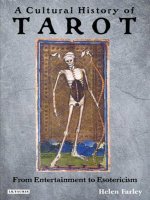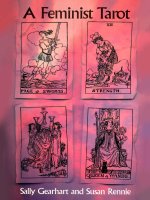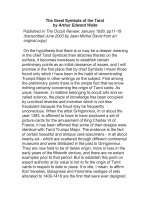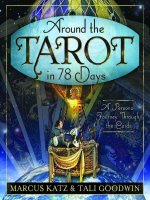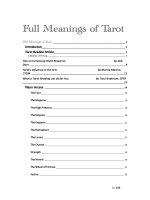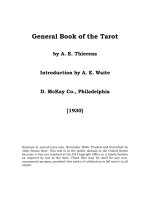Hướng dẫn bói bài Tarot A cultural history of tarot from entertainment to esotericism
Bạn đang xem bản rút gọn của tài liệu. Xem và tải ngay bản đầy đủ của tài liệu tại đây (2.74 MB, 283 trang )
A Cultural History of Tarot
ii
A CULTURAL HISTORY OF TAROT
Helen Farley is Lecturer in Studies in Religion and Esotericism at the
University of Queensland. She is editor of the international journal
Khthónios: A Journal for the Study of Religion and has written widely on a
variety of topics and subjects, including ritual, divination, esotericism and
magic.
CONTENTS
A Cultural History of Tarot
From Entertainment to Esotericism
HELEN FARLEY
iii
Published in 2009 by I.B.Tauris & Co Ltd
6 Salem Road, London W2 4BU
175 Fifth Avenue, New York NY 10010
www.ibtauris.com
Distributed in the United States and Canada Exclusively by Palgrave Macmillan
175 Fifth Avenue, New York NY 10010
Copyright © Helen Farley, 2009
The right of Helen Farley to be identified as the author of this work has been
asserted by the author in accordance with the Copyright, Designs and Patents Act
1988.
All rights reserved. Except for brief quotations in a review, this book, or any part
thereof, may not be reproduced, stored in or introduced into a retrieval system, or
transmitted, in any form or by any means, electronic, mechanical, photocopying,
recording or otherwise, without the prior written permission of the publisher.
ISBN 978 1 84885 053 8
A full CIP record for this book is available from the British Library
A full CIP record for this book is available from the Library of Congress
Library of Congress catalog card: available
Printed and bound in Great Britain by CPI Antony Rowe, Chippenham
from camera-ready copy edited and supplied by the author
v
CONTENTS
Contents
List of Illustrations
List of Tables
Acknowledgements
Introduction
vii
ix
xi
1
Chapter 1: Origins and Antecedents
The Emergence of the Playing Card Deck
Some Theories of Tarot Origin
6
8
18
Chapter 2: Renaissance Italy and the Emergence of Tarot
The First Tarot Deck
The Viscontis and the Italian Renaissance
The Purpose of the Deck
Tarot Imagery
33
35
39
43
45
Chapter 3: An Alternative Explanation of Tarot Symbolism
The Magician/Il Bagatella
Temporal and Spiritual Power: The Emperor and Empress, the Pope and
the Popess
Love
The Chariot Misidentified
The Virtues: Fortitude, Justice and Temperance
The Old Man as Time
The Wheel of Fortune
The Hanged Man
Death
The Star, Moon and Sun: Astrology in Renaissance Italy
Angel
The World
Not a Tarot Trump but still the Fool
The Tower: Absent or Lost?
The Devil in the Deck
50
51
Chapter 4: The Transformation of Tarot into an Esoteric Device
France in the Eighteenth Century
Occult Philosophies
Antoine Court de Gébelin
Etteilla
52
58
60
62
68
69
70
73
76
79
80
82
84
88
93
95
98
101
106
vi
A CULTURAL HISTORY OF TAROT
Éliphas Lévi
Papus
111
117
Chapter 5: Across the Channel to England
The Nature of British Occultism
William Wynn Westcott
S. L. Mathers
The Hermetic Order of the Golden Dawn
Aleister Crowley
William Butler Yeats
Arthur Edward Waite
121
122
126
128
129
137
142
144
Chapter 6: Tarot and the New Age
Predominant Themes of New Age Thought
Combining Traditions and Methods
The Influence of Feminism
Neopaganism
A Fascination with other Religions and Cultures: Great and Small
History Repeating
151
152
157
159
161
165
169
Conclusion
173
Notes
Bibliography
Index
177
235
265
CONTENTS
vii
Illustrations
1.
2.
3.
4.
5.
6.
7.
8.
9.
10.
11.
12.
13.
Mamlnjk playing cards now housed in the Topkapi
Sarayi Museum, Istanbul.
The Tarocchi Players, Casa Borromeo, Milan.
The Bishop by Hans Holbein, first half of the sixteenth century.
The Popess from the Visconti-Sforza deck housed in the
Pierpont Morgan Library, New York.
Fortitude from the Visconti-Sforza deck housed in the
Pierpont Morgan Library, New York.
The Hanged Man from the Visconti-Sforza deck housed
in the Pierpont Morgan Library, New York.
Death from the Visconti Sforza deck housed
in the Pierpont Morgan Library, New York.
The Fool from the Visconti Sforza deck housed
in the Pierpont Morgan Library, New York.
The Moon from a contemporary version of the Tarot of Marseille.
The Devil from a contemporary version of the Tarot of Marseille.
The World from a contemporary version of the Tarot of Marseille.
The Hanged Man recast as Prudence by Antoine Court de
Gébelin in Le Monde Primitif.
Isis figures in Court de Gébelin’s version of The Star in Le
Monde Primitif.
Lévi’s Baphomet as the Devil in Dogme et rituel de la haute magie.
Lévi’s Chariot as portrayed in Dogme et rituel de la haute magie.
The Moon card as represented in the Cipher Manuscript.
The Hierophant from Crowley’s Thoth Tarot.
Lust replaces Strength in Crowley’s trump sequence.
The Magus from Crowley’s Thoth Tarot.
The Fool from the Rider Waite deck.
The High Priestess from the Rider Waite deck.
Death from the Rider Waite deck.
The Kaiser replaces the Emperor in the Anti-Nuclear
Wendländisches Tarot (1980).
24. Black Tortoises replace wands in the Feng Shui Tarot of
Eileen and Peter Paul Connolly.
25. Odin plays the role of Emperor in the Haindl Tarot.
26. Marie Laveau replaces the Priestess in the New Orleans
Voodoo Tarot.
14.
15.
16.
17.
18.
19.
20.
21.
22.
23.
14
35
48
56
65
71
74
83
94
95
96
102
103
116
118
135
137
138
140
145
146
147
154
158
161
167
viii
A CULTURAL HISTORY OF TAROT
27. Simbi d’l’eau adorns the equivalent of the 8 of Cups in the
New Orleans Voodoo Tarot.
28. The Wild Card is a novel addition to the New Orleans Voodoo
Tarot.
168
169
CONTENTS
ix
Tables
1.
2.
Region-specific suit signs of tarot and ordinary playing cards.
The alignment of the ‘celestial princes and barons’
with the four orders.
3. Structure of the Etteilla tarot deck.
4. A comparison of Etteilla’s tarot cards with the Tarot de
Marseille tarot trumps.
5. A table of correspondences to Hebrew letters formulated
by Athanasius Kircher. Planetary spheres were arranged according
to their supposed distance above the earth, from Saturn to
the Moon as the closest.
6. Correspondences associated with tarot suit signs according
to Éliphas Lévi.
7. Table of correspondences between the tarot trumps and the
Hebrew letters according to Éliphas Lévi and the Cipher Manuscript.
8. Correspondences as given in the Sefer Yesi̛ rah, by Papus
and in the Cipher Manuscript.
9. Court card correspondences as described by Mathers
in Book T.
10. The table of correspondences drawn up by Yeats while he
was still a member of the Theosophical Society.
11. A table of correspondences between the four tarot suits and
other systems including Jung’s four functions of personality used
in the New Tarot.
7
36
108
110
115
117
133
134
136
143
156
x
A CULTURAL HISTORY OF TAROT
ILLUSTRATIONS
xi
Acknowledgements
A book is a substantial undertaking and it cannot be completed without
considerable support from colleagues, friends and family. I am fortunate in
that I am well-endowed with all those people such that I hardly know how to
whittle down my list. I would like first to thank Professor Emeritus Philip
Almond who has uncomplainingly read drafts and made many helpful
suggestions.
Research travel is very expensive and I could not have undertaken it
without the generous financial support of the University of Queensland
Graduate School through the Graduate School Research Travel Award
scheme. I would also like to acknowledge the generous support of the
School of History, Philosophy, Religion and Classics and also to the
Australian Association for the Study of Religion (AASR) for providing me
with the funds to attend conferences and spread the seeds of my academic
exploration.
My research in Milan and London was greatly facilitated by many people
who had not previously met me yet bent over backwards to meet my needs. I
would particularly like to mention Patrizia Foglia at la Raccolta Bertarelli at
the Castello Sforzesco in Milan. In London, I would like to extend my
gratitude to John Fisher of the Guildhall Library; Jo Norman of the
Department of Prints and Drawings at the British Museum; Frances Rankine
of the Prints and the Book, Word & Image Department of the Victoria and
Albert Museum and the staff of the National Art Library.
From I.B.Tauris I would like to express my gratitude to Alex Wright who
believes that a book about tarot is viable! Thanks must also go to Jayne Hill
who has tirelessly pored over my copy; every comma and fullstop.
I reserve my thanks til last to my partner, James Boland, for his
encouragement, support and good humour; for listening to the complicated
exposition of my arguments when he would rather have been playing his
guitar and for celebrating every word, every chapter and every milestone
along the way.
Introduction
When we think of tarot, images of fortune-tellers, crystals and incense flash
past our mind’s eye. Those with more romantic dispositions may imagine
dark-eyed gypsies in colourful caravans, wending their way through the
countryside, telling fortunes with cards for the curious few brazen enough to
peek at their destiny before its blossoming. Outsized cards are shuffled, laid
out and ‘read’; the order in which they are drawn, their symbolism and their
position relative to each other are all significant for folk with eyes to see.
Those who wish to possess a pack for themselves are confronted by a
bewildering variety of decks: pagan tarots, astrological tarots, gypsy tarots, any
number of Egyptian tarots, even a Metrosexual Tarot.1
In contemporary society where empirical scientific enquiry and strict
rationalism are paramount, tarot has been associated with shoddy
soothsayers and confidence tricksters, and it is in part for this reason that
academics have deemed the area unsuitable for detailed examination.
Though there is a paucity of scholarly works, there are numbers almost
without limit of popular tarot monographs, which line the shelves of New
Age bookstores and ‘Self-Help’ corners of department stores. In embarking
on an academic study, it is difficult to separate historical fact from esoteric
fiction, where elegant myths are recycled ad infinitum. Many authors would
have us believe that the tarot contains the lost Hermetic knowledge of a
proud and noble Egyptian race who encoded their secrets when faced with
untimely extinction. Such myths, never verified by their perpetrators, have
their origin in the desire for pseudo-legitimacy through an ancient, though
false, lineage and the dogged persistence of a pre-Rosetta infatuation with all
things Egyptian.
In order to correct this deficiency, this book forms the first comprehensive
cultural history of the tarot deck and its imagery. The symbolism, changes in
patterns of use and theories of tarot origin become entirely comprehensible
when viewed in conjunction with the cultural contexts in which they
occurred. Four significant periods in tarot’s history are considered, beginning
with an investigatation of the popular theories of the deck’s provenance in
order to accurately determine the circumstances of its invention. The
reclusive Duke Filippo Maria Visconti of Milan is the most likely candidate
for inventor of that first deck, sometime early in the fifteenth century. A close
investigation of the spiritual and mundane concerns of the Italian
2
A CULTURAL HISTORY OF TAROT
Renaissance brings to light the meaning in the mysterious symbolism of these
early decks; at this time used solely for game playing. Could it have been that
that this innocuous game of some skill and much chance was an allegory for
the life of the Viscontis as rulers of Milan, similarly characterised by a
dizzying mix of rat-cunning and luck?
In late-eighteenth-century France, tarot was so far removed from its
original cultural context that the ready decryption of its symbolism became
impossible. Instead it was reinterpreted according to a new set of intellectual
currents which included an infatuation with exotic cultures, esoteric doctrines
and an ardent yearning for a lost Golden Age. In particular, France was
gripped by Egyptomania, fuelled by Napoleon’s conquest of that exotic land.
The failure of the Church to adapt to the changing political, social and
spiritual circumstances enabled the emergence of the alternative and esoteric
doctrines which would constitute the French Occult Revival. It was in this
milieu that tarot was transformed from a Renaissance game to an esoteric
device, legendarily created in an Egypt still perceived to be the repository of
arcane knowledge. It was linked to all manner of abstruse schemes including
Hermeticism, astrology and kabbalah by esotericists, most notably Éliphas
Lévi and Gérard Encausse, otherwise known as Papus.
The next significant development in tarot occurred in England, also in the
grip of the Occult Revival. Under the influence of the Hermetic Order of the
Golden Dawn, tarot would become central. Though never possessing more
than 300 members, the Golden Dawn was enormously influential on the
practice of magic and tarot interpretation. These nineteenth-century
magicians altered the trump sequence and linked each card to one of the
twenty-two pathways between the sephiroth on the kabbalistic Tree of Life.
These pathways lent a divinatory interpretation to each card which forms the
basis of contemporary divinatory meanings.
Two Golden Dawn members who would play a significant role in the
evolution of tarot were Aleister Crowley and Arthur Edward Waite. Crowley
extended the lists of correspondences between the tarot trumps and other
esoteric systems. But it was Waite who was to be the major innovator by
designing a pack in which the minor arcana or pip cards were illustrated to
facilitate divination. The deck he designed, commonly known as the RiderWaite deck, was to become the most popular in the history of tarot.
With the advent of the New Age, the tarot underwent yet another
transformation. Though retaining its primary purpose of divination, the
nature of that divination shifted; where once the deck was used for fortunetelling, the object became healing and self-development, both central to the
New Age movement. In addition, New Age seekers were intrigued with
Eastern and indigenous religions, searching for commonalities that would
expose an underlying truth in all the world’s spiritual systems. The New Age
INTRODUCTION
3
adoption of Jungian psychology justified many of its practices including the
liberal use of the theory of archetypes to validate ad hoc borrowings and
substitutions from other cultures in the symbolism of tarot. So too, the
structure of the deck became fluid, subservient to its ultimate purpose.
In glaring contrast to religious trends in the West which were moving
towards greater secularisation, tarot has shifted from the mundane towards
the sacred. It began its life as a game with no purpose beyond providing
mental stimulation. It contained no esoteric wisdom, could provide no
spiritual advice and gave no clue as to how to conduct one’s life. True
enough, these matters were implied in the symbolism of the trump sequence,
but it was not the purpose of the deck to provide answers, merely to
acknowledge the existence of such factors. In contrast, the esotericists of the
Occult Revival imbued tarot symbolism with esoteric meaning. Still, tarot was
used only by a select few who were initiated into its mysteries; being seen as
too powerful a tool to be left in the hands of anyone without the appropriate
knowledge and skill; madness and ruin lay along that path. In contrast, New
Age tarot is nothing if not accessible. Though there are large numbers of
professional readers, a tarot deck and instructional guide are available to
anyone with some money and a little time.2 Obviously, it is the social and
cultural context in which tarot is operating that imbues the deck with
meaning and given the variety of contexts, it becomes more realistic to
discuss the ‘cultural histories’ of tarot, rather than ‘cultural history’ in the
singular.
Most tarot historians examine an aspect of the deck in isolation. Scholars
of western esotericism busy themselves with the possible occult significance
of the cards and forge tenuous links to other arcane traditions while turning a
blind eye to alternative explanations of the symbolism. Historians of games
are entirely focused on that aspect of the deck’s multifaceted history. Art
historians focus only on the artistic significance of a card within the wider
context of that period’s art. I will draw on all of these disciplines to posit the
significance of tarot symbolism and trace the development of the tarot deck.
This book will form part of the lively discourse surrounding the academic
study of the history of esotericism. Because of the changing function of the
deck and the ambiguity surrounding its origins, it has been difficult to locate
tarot within this discourse. Further, in an area where scholars are clambering
to gain recognition for the discipline, they are inclined to distance themselves
from tarot which is still regarded as suspect in contemporary society.
In recent times there has been some recognition that occultism has played
a significant role in the development of Western thought. Warburg scholar
Dame Frances Yates has been very influential in this arena. Her works
including The Rosicrucian Enlightenment,3 Giordano Bruno and the
Hermetic Tradition4 and The Occult Philosophy in the Elizabethan Age5
4
A CULTURAL HISTORY OF TAROT
have done much to legitimise the study of esotericism in the academic world.
In more recent times Antoine Faivre and Wouter J. Hanegraaff have taken
up the baton, working to establish the study of esotericism as a legitimate
discipline.6 Their focus, however, tends to be narrow and larger social,
economic and cultural currents are downplayed or disregarded in their
desire to elevate the investigation of the development of esoteric doctrine
and practice. This approach, when applied to tarot, becomes especially
problematic as tarot’s origins were firmly grounded in the secular, only
achieving esoteric significance towards the end of the eighteenth century.
The study of esotericism finds little of interest in the early genesis of the
game of tarocchi in the courts of northern Italy.
Similarly, the focus of art historical studies is stiflingly narrow. Authors in
this area are primarily concerned with how tarot fits into the larger schema of
Renaissance art. They are concerned with the ‘who’ and ‘when’ of tarot,
rather than the ‘why’. These studies help to determine when a work was
likely to have been created, the original geographical location and under
whose patronage the work was undertaken, certain courts or church
administrators favouring particular artists at specific times. Art historians,
however, show little interest in the subject of the artistry, the symbolism
portrayed therein, the subsequent development of the deck or the cultural
milieu in which it resided.
Playing card collectors and enthusiasts have done much to augment the
available information about tarot. Alas, most collectors are at best
enthusiastic amateurs, frequently ignorant of academic rigour, regurgitating
popular myths without corroboration. However, there is much to be gleaned
from them and their collections. In later years there have been a few names
that are synonymous with reliable and careful research including Detlef
Hoffmann,7 Sylvia Mann and philosopher cum tarot enthusiast Michael
Dummett.8 Dummett in particular has contributed some works which have
become the starting point for anyone interested in the field, including The
Game of Tarot (written with Sylvia Mann), A Wicked Pack of Cards
(authored with Ronald Decker and Thierry Depaulis) and A History of the
Occult Tarot: 1870–1970 (authored with Ronald Decker). Though
Dummett exhibits careful scholarship, he is barely able to contain his
contempt for the esotericists who have ‘appropriated’ the game of tarot for
their own ends. Admittedly, he tends to moderate his opinion in his later
works.9
Prejudices aside, card collectors have made a careful study of the
evolution of both ordinary playing cards and tarot cards. They have traced
the origins of playing cards in Europe from those imported from Egypt;
recognising a similarity in suit signs without obvious precursors. Card
collectors are interested not only in standardised packs but also non-standard
INTRODUCTION
5
packs, though they do tend to play down the significance of the latter,
preferring to trace a linear development. In doing so they are neglecting a
valuable clue. By looking at the larger corpus, similarities between
superficially divergent decks and trends in symbolic representation may be
observed. A close scrutiny of contemporaneous decks may provide a unique
snapshot of the interplay of competing currents in Renaissance thought and
life.
The study of tarot requires a multidisciplinary approach. First, the paucity
of material precludes any claim that one discipline is able to provide
sufficient information to achieve the objectives of this study. Second, the
history of tarot sees the usage of the deck undergo a radical change from that
of card-playing in the Italian Renaissance to its use as an esoteric document
towards the end of the eighteenth century. Art historical studies and the data
amassed by card collectors can help determine the early history of tarot but it
is the study of esotericism that charts its subsequent course.
Though cultural historians have made no particular study of tarot, their
work is invaluable in helping to determine prevailing attitudes during the
periods under consideration. Looking beyond the significant names and
dates which are the fodder of conventional historical studies, cultural
historians seek to reconstruct the culture and ideas of a particular group or
groups of people.10 It becomes possible to speculate about a population’s
attitude to religion and to the supernatural, popular pastimes and familial
relationships. What once may have seemed irrational and illogical to us as
twenty-first century observers, becomes rational when presented within the
framework of a fifteenth-century worldview for example, one burdened with
a distinct cosmogony and the firsthand experience of plague, war and a
growing individualism. If we can look at tarot in this context, it ceases to
become the mysterious and slightly dangerous entity it first appears. Instead,
it becomes the wholly comprehensible reflection of the people that created
and used it. Cultural historical studies can provide the context in which tarot
resides; providing clues as to why tarot was used so differently at different
times. An awareness of the modes of culture and prevailing attitudes both
during the Renaissance and during the Occult Revival will help us to make
sense of the symbolism of each period’s tarot decks.
1
Origins and Antecedents
To a contemporary user of tarot, the original meanings of the mysterious
images displayed on the cards are hidden. In our world, the skeletal figure of
death does not ride a horse and people are rarely hanged (and never by their
feet). In order to discern the original significance of tarot symbolism, it
becomes necessary to establish the true provenance of the deck. Images that
held an implicit meaning in a certain context may have an altered
connotation in another. The theories regarding the origins of tarot are
diverse, ranging from its creation in ancient Egypt by a mysterious priesthood
or an evolution from any of a number of extant games. Careful consideration
must be given to each because the implications for the interpretation of tarot
symbolism are considerable. Does tarot contain a carefully coded esoteric
doctrine or was it designed merely as an innocent distraction? The question
cannot be answered without a clear picture of the origins of the tarot deck
and the use for which it was designed.
It is counterintuitive to suppose that any new invention would first appear
in its final form. It is far more likely that there would be a series of false
starts, refinements and revisions and so it was with tarot. Evidence suggests
that the tarot deck evolved from the card-playing deck familiar in most
western countries. There are certain similarities in structure and symbolism
which are suggestive of this close relationship. The playing-card deck
consisted of fifty-two cards distributed through four suits. Each suit contained
numbered cards 1 (Ace) to 10, with three court cards. Henceforth, this pack
will be referred to as the ‘ordinary playing card deck’ or ‘regular deck’.
Though tarot exists in many variations, the standard tarot deck consists of
seventy-eight cards. Of these, twenty-one are ordered trumps, which are
often counted with an unnumbered ‘wild’ or Fou (Fool) card.1 It is the
symbolism resplendent on these that forms the main focus of this enquiry.
Possessing a similar structure to the ordinary playing card deck, the
complement of the tarot deck contains four suits of sixteen pip cards,
indicative of tarot’s original role in game-playing.2 Each suit boasts numbered
cards from 1 (Ace) to 10, with the addition of the four court cards of Knave,
7
ORIGINS AND ANTECEDENTS
Knight, Queen and King. Originally, tarot adopted the Italian suit signs of
the regular playing card deck which predated it; these are Cups (Coppe),
Batons (Bastoni), Coins (Denari) and Swords (Spade). These marks
correspond to the modern English and French suit signs of Hearts (Coeur),
Clubs (Trèfle), Diamonds (Carreau) and Spades (Pique) respectively. As
card games played with both the regular deck and tarot deck spread from
Italy across Europe, suit signs developed into distinctive, region-specific
patterns as evidenced in the table below.
ITALIAN
ENGLISH
FRENCH
SPANISH
GERMAN
CUPS
Coppe
Hearts
Coeur
Copas
(Cups)
Herzen
(Hearts)
SWITZERLAND Rosen
(Roses)
BATONS
Bastoni
Clubs
Trèfle
Bastos
(Batons)
Eicheln
(Acorns)
COINS
Denari
Diamonds
Carreau
Oros
(Gold)
Schellen
(Bells)
Eicheln
Schellen
SWORDS
Spade
Spades
Picque
Espados
Laube or
Grüne
(Leaves)
Schilten
(Shields)
Table 1: Region-specific suit signs of tarot and ordinary playing cards.
3
Certainly, the most intriguing feature of the tarot deck was the novel
addition of the twenty-one trump cards and Fool to the cards of the four
suits. In this way, the structure of the tarot deck diverged markedly from that
of its progenitor. Originally unlabelled, the trumps bear the names of the
Magician, the Popess, the Empress, the Emperor, the Pope, the Lovers, the
Chariot, Strength, the Hermit, the Wheel of Fortune, Justice, the Hanged
Man, Death, Temperance, the Devil, the Tower, the Star, the Moon, the
Sun, Judgment and the World. The names of the trumps, the elaboration of
the symbolism on them and their rank order, varied between individual
decks, depending on their geographical origin, purpose and the intent of the
artist who created them. These factors will be examined in more detail later.
In addition, tarot distinguishes itself from the regular playing card deck by
possessing four court cards instead of three. Because of our familiarity with
English decks, it is tempting to assume that the additional card in the court of
tarot was the Knight, but in reality the Queen was the interloper.4 It is only in
the regular French and English decks that we find a female presence.
Outside of these dominions, the court is an all-male affair. For instance, the
8
A CULTURAL HISTORY OF TAROT
courts of decks from Germany and Switzerland are populated by the König,
Obermann and Untermann, all of which are male.5
As games played with tarot evolved, so did the deck to reflect these
changes. Tarocchino (or ‘little tarot’), was a reduced deck of just sixty-two
cards; the pip cards from 2 to 5 being omitted.6 Count Leopoldo Cicognara
erroneously attributed the invention of this modified deck to Francesco
Antelminelli Castracani Fibbia, the prince of Pisa who was exiled in Bologna
in the fifteenth century.7 The Minchiate of Florence was yet another variation
on the theme of tarot. The controversial Popess card was removed but the
number of trumps was augmented by the addition of the Cardinal Virtue of
Prudence, the three Theological Virtues, the four elements and the twelve
signs of the zodiac, to create a deck of ninety-seven cards.8
The Emergence of the Playing Card Deck
Many commentators on the history of tarot have reported that the ordinary
playing card deck evolved from the tarot deck by a process of simplification.9
As evidence, they frequently presented the Joker of contemporary playing
cards as the last remnant of the tarot trumps, representing the Fool.10 But in
reality, the Joker did not supplement the deck until the mid-nineteenth
century, when it was added to decks in America in order to play certain card
games.11 Further, the Joker and the Fool had different roles in the games in
which they were utilised. Given this slim evidence, it is exceedingly unlikely
that the invention of the tarot deck predated the creation of regular playing
cards.
Ample circumstantial evidence supports the hypothesis that the regular
deck appeared in Europe before the creation of tarot. The first references to
the ordinary playing card deck appeared in prohibitions against gambling and
in sermons at least fifty years before the first documented appearance of
tarot.12 In the prodigious catalogue of books describing the history of playing
cards, historians report the existence of manuscripts which place the first
appearance of cards sometime towards the end of the thirteenth century.13
Alas, these references are impossible to verify and a more reliable date can
be set at 1371 when Peter IV, King of Aragorn, commissioned a deck of
cards from the Catalan Jaume March.14 A scant half dozen years later in
1377, the German monk Johannes of Rheinfelden in Switzerland, described
a deck as ‘the common form and that in which it first reached us,’ consisting
of thirteen cards in four suits, each made up of ten numeral cards and three
court cards consisting of a King, an upper Marshal and a lower Marshal.15
The ludus cartarum (‘game of cards’) had been introduced into Switzerland
in the same year and was quickly prohibited.16 Almost simultaneously, cards
were mentioned in a range of bureaucratic documents including inventories
ORIGINS AND ANTECEDENTS
9
of possessions, edicts, city chronicles and account books in the cities of
Siena, Florence, Paris and Basle.17
From the mid-fourteenth century, cards were frequently mentioned,
usually incidentally, across Europe. In 1480, Juzzo da Coveluzzo wrote in his
Istoria della citta di Viterbo (History of the City of Viterbo): ‘There were
encamped about Viterbo paid troops of the opposing factions of Clement
VII and Urban VI, who did commit depredations of all kinds, and robberies
in the Roman states. In this year of such great tribulations the game of cards
was introduced into Viterbo, which came from the Saracens and was called
“Naib”.’ This narrative passage described events that took place in 1379,18
and was also reported by Nicolo delle Tuccia in 1476.19 In many areas, card
games went by the name of ‘naib’ or ‘naipes’.
In 1380, the first references to cards in Spain appeared in an inventory of
the goods owned by Nicholas Sarmona. The wording referred to ‘a game of
cards comprising forty-four pieces’.20 Unfortunately, from this scant
information, it is impossible to deduce the exact composition of the pack. A
prohibition against card games in Ulm, Germany, dates from 1397.21
Certainly, there was no mention of the trump cards that distinguish tarot
from the regular deck in any of the references so far cited, and it is logical to
deduce that tarot was not yet evident in Europe.
From the proliferation of references to cards from the 1370s and the prior
absence of such mentions before this, it is safe to assume that playing cards
entered Europe in the last quarter of the fourteenth century.22 The deck’s
entry point was almost certainly through the prosperous seaport of Venice
which conducted a brisk trade with the countries of the East and the Near
East.23 By this time, the deck already had a stable structure of fifty-two cards
distributed through four suits. It seems highly unlikely that cards were a local
invention, there being no evidence of progenitor or transitional decks.24 If the
concept of the regular playing card deck was imported into Europe, there
were several popular theories as to its origin and likely route to the
Continent. Frequently, playing-card historians have looked to contemporary
or near contemporary card-game or even board-games in other parts of the
world on which to base their hypotheses.
There are many theses regarding the provenance of the fifty-two-card
deck. One of the most popular suggests that the Indian game of Ganjifa was
the progenitor of the regular deck.25 The cards were round and made of
layers of lacquered wood or cloth, usually hand-painted and the customary
suit signs represented the various incarnations of the Hindu god 9LVѽQѽX.26
There were twelve cards to each suit, numbered from 1 to 10 with two court
cards. One of the court cards represented one of the ten incarnations of
27
9LVѽQѽX, and the other showed some incident associated with this incarnation.
The suit signs were:
10
A CULTURAL HISTORY OF TAROT
1. The Suit of Fish that signified Matsya the Fish, who towed the ship
containing Manu (the first man) and saved him from the great
Deluge.28
2. The Suit of Tortoises that signified Kurma the Tortoise, on which
rested the mountain that, when turned by the serpent Vasuki,
disturbed the sea of milk and produced the Fourteen Gems which
had been lost in the Deluge.29
3. The Suit of Boars that signified Varaha the Boar, who destroyed the
giant Hiranyaksha and raised the earth up out of the ocean.30
4. The Suit of Lions which represented Narasimha the Lion, who
destroyed the giant Hiranyakashipu.31
5. The Suit of Dwarves or Water Jars which symbolised Vamana the
Dwarf Brahmin, who saved men from the giant king Bali, who was
to have dominion over the lower world.32
6. The Suit of Axes that represented Paraśurāma of the Axe, who
punished the military caste (Kshatriya) and obliterated their power
twenty-one times.33
7. The Suit of Arrows which signified Rāmachandra. Rāma avenged
men and the gods for the crimes perpetuated by Ravana, the demon
king of Ceylon. He won his wife Sītā in a contest with arrows.
8. The Suit of Quoits representative of .UѽVѽQѽD, believed to be the perfect
manifestation of 9LVѽQѽX. His emblem was the Chakra or quoit of
lightning which he hurled at his enemies. This suit was sometimes
called the Suit of Cows, because .UѽVѽQѽD, as a youth, lived among the
cowherds.
9. The Suit of Shells was symbolic of Buddha the Enlightened, who sat
upon his shell-shaped throne in meditation.
10. The Suit of Swords or occasionally called Horses represented Kalki,
the White Horse. This incarnation is yet to come and 9LVѽQѽX, with
sword in hand, will sweep triumphant through the world, eliminating
the powers of darkness and ushering in a better age.34
There is an intriguing connection between Indian and European card
games: in both cases, numeral cards were reversed for some suits during
play. But this is insufficient to confirm a relationship between the two.
Games utilising this strategy were common in Europe long before sea trade
between the two regions was enabled by Vasco da Gama of Portugal in
1498.35 Further substantiation is required to demonstrate an Indian
provenance and a deck intermediate between the European pack and Indian
Ganjifa could expose such a direct evolutionary relationship. A particular
eighteenth-century Ganjifa pack housed in the British Museum was a
possible candidate. Even though this deck shared two suit signs with the
original Latin playing card decks and each suit boasted court cards in a
ORIGINS AND ANTECEDENTS
11
manner suggestive of European decks, it seems probable given its late date of
manufacture, that this Ganjifa pack was influenced by the European deck
rather than the other way around.36 Further, the theory that advanced Ganjifa
cards as the immediate progenitors of the standard deck was confounded by
the late appearance of the Indian cards which were unknown on the
subcontinent before the sixteenth century.37
An alternate theory advocating an Indian ancestry for European cards
utilised images of the four-armed, androgynous Hindu god Ardhanari.
Traditionally, Ardhanari was represented as being the composite of Śiva and
his consort Devi, and was often depicted holding a cup, a sceptre, a sword
and a ring. Sometimes it was the monkey-god Hanuman who was pictured
holding these emblems. This theory contended that the Italian suit signs of
cups, batons, coins and swords were derived from these emblems, though
the possible motivations for transferring this symbolism to European playing
cards was unclear; as was the special relevance that this deity had over all
those represented in Indian culture.38 The absence of Indian decks utilising
this symbolism and the lack of documentation relating to transitional decks,
made this hypothesis untenable.
Another long-cherished theory of an Eastern derivation for the regular
deck put the creation of the cards firmly in China. After all, the northern
Italian cities such as Venice had established a trade relationship with China
and it is readily conceivable that returning sailors or travellers could have
brought decks or the idea of a deck home with them.39 Another theory yet
more exotic had the cards travelling along the Peking-to-Samarkand silk
route in caravans of camels carrying spices and rhinoceros horns. Once at
Samarkand, the cards (together with the other precious cargoes), would be
transported through Persia and the Holy Land, being brought to Europe with
Arab traders or Christian Crusaders.40 Some theories have the cards directly
transported by that great adventurer of the medieval world, Marco Polo.41
The Far East also seemed a likely choice because the production of cards
required both the technology of printing and paper, both of which were
invented in China long before their appearance in Europe.42 American
scholar Thomas Francis Carter thought that it was probable that Chinese
playing cards evolved from certain forms of divination, the drawing of lots
and paper money. These ‘sheet-dice’ almost certainly constituted the earliest
form of block printing and according to Ou-yang Hsiu (1007–1072CE),
began to appear before the end of the T’ang dynasty (618–907CE).
Interestingly, Carter hypothesised that these ‘sheet-dice’ were also the remote
ancestors of dominoes.43
The earliest source that specifically referred to playing cards was the Liao
shih of T‘o-t‘o, a history of the Liao dynasty dating back to 969CE, stating
that the Emperor Mu-tsung played cards (yeh ke hsi) on the night of New
12
A CULTURAL HISTORY OF TAROT
Year’s Eve.44 The oldest extant Chinese playing card dates from the eleventh
century, around 300 years later. Found by Dr A. von Le Coq in 1905, it is
known as the Turfan card, named for where it was found in Chinese
Turkistan. It appears to be a direct ancestor of the cards used for chiup’ai, a
game still evident in the eighteenth and nineteenth centuries.45
The Chinese deck most like the regular European deck was that consisting
of ‘money’ cards. The deck consisted either of three or four suits
representing monetary values, with cards numbered from 1 to 9 in each suit.
The suits typically consisted of Cash, Strings (of cash), Myriads (of strings)
and Tens (of myriads).46 The deck did differ from European decks in that
there was no division of suits into numeral and court cards. Further, some
cards did not possess genuine suit signs, instead bearing their number and
the name of the suit.47
Though the Chinese were certainly using playing cards for at least 200
years before the deck’s arrival in Europe, this fact alone is insufficient to
nominate the Chinese pack as the immediate forerunner of the European
deck. The Chinese cards lacked court cards and there would have to have
been considerable development before the pack’s appearance in Europe.48 In
addition, the idea that the Chinese suit signs were misrepresented in
European packs, erroneously manifesting as Cups, Batons, Coins and
Swords seems highly improbable.49 Documentary evidence also fails to back
up the theory of Chinese origin. The only record of such a theory before
recent times comes from the Italian author Valère Zani writing in 1696. He
stated that: ‘The Abbe Tressan [a French missionary to Palestine, 1618–
1684] showed me when I was at Paris a pack of Chinese cards and told me
that a Venetian was the first who brought cards from China to Venice, and
that that city was the first place in Europe where they were known.’50 Though
it is possible that the Venetian sailor did bring back a pack of Chinese cards,
for the reasons outlined above, it is unlikely that these significantly influenced
the design of the first European playing cards. This does not rule out
Chinese cards as the remote ancestors of European playing cards.51
Almost by a process of elimination, it becomes likely that the immediate
progenitor of the regular European deck was from the Islamic world, as
Europe had little direct contact with countries not mediated by Islam. The
cards could have entered Europe via Muslim Spain or via Italy.52 In fact, the
commercial privileges of Venetian traders were protected by a treaty
negotiated with the Mamlūk Empire of Egypt and Syria in 1302 and again in
1345.53 Sometimes, the Papacy and Crusading powers would impose trade
embargoes against the Mamlūks, but these were readily circumvented, using
Cyprus as an intermediary.54
Not only was there a direct trade with the Muslim countries providing the
opportunity, but documentary evidence also favours an Arabic derivation for
